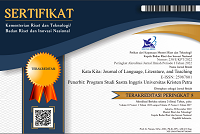The Absence of Love and Hopes of Shion Uzuki in The Xenosaga Trilogy
DOI:
https://doi.org/10.9744/katakita.1.1.%25pKeywords:
Kata Kunci — Anak Yatim Piatu, Grha, Lansia, Panti Asuhan, Pemukiman.Abstract
Among video games, The Xenosaga Trilogy is widely recognized due to its complex storyline. The psychological struggle of the main character, Shion Uzuki, is one of the aspects that drives the story from the beginning up to its conclusion. Despite her seemingly bright personality, Shion has an absence of love and hopes, as she lives her life monotonously without any set goal. It later leads her to develop a strong attachment to KOS-MOS, an android. As such, in this study, we want to analyze the reasons Shion has the absence of love and hopes in the first place and the ways she struggles to recover from that absence. In order to answer these questions, we use 3 psychological theories, namely Post-Traumatic Stress Disorder (PTSD), Transference, and Countertransference. We find out that Shion’s absence of love and hopes is apparently caused by her traumatic past and her PTSD. As a unconscious response to this, Shion tries to recover by using transference. This attempt fails, but Shion is finally healed thanks to KOS-MOS’ countertransference. In conclusion, Shion fully recovers from her traumatic past and PTSD because of KOS-MOS’ countertransference instead of her own transference.References
A.C, A.C. (2011, October). Tetsuya Takahashi. Retrieved from http://xenoverse.xenotensei.com/
Bakarich, C. (2005, March). Xenosaga episode II: Jenseits von gut und bose. Retrieved from http://www.gamefaqs.com
Bakarich, C. (2006, September). Xenosaga episode III: Also sprach zarathustra. Retrieved from http://www.gamefaqs.com
Carson, D. n.d. Environmental storytelling: creating immersive 3D worlds using lessons learned from the theme park industry. Gamasutra. Retrieved from http://www.gamasutra.com/view/feature/3186/environmental_storytelling_.php
Colman, A.M. (Ed.). (2008). Dictionary of psychology. Oxford.
Conner, M. J. (2009, January 1). Transference: Are you a biological time machine? crisis counselling. Retrieved from http://www.crisiscounseling.com/articles/transference.htm
Esposito, N. (2005). A short and simple definition of what a videogame is. Retrieved from University of Technology of Compiègne, Compiègne, Research Center website www.utc.fr/~nesposit/publications/
Hughes, P. & Kerr, I. (2000). Transference and Countertransference in Communication between Doctor and Patient. Advances in Psychiatric Treatment, 6, 57–64. doi:10.1192/apt.6.1.57
Jenkins, H. (2004). Game design as narrative architecture. Retrieved from Massachusetts Institute of Technology, Cambridge, Comparative Media Studies website http://web.mit.edu/cms/People/henry3/games&narrative.html
Kong, O. (2005). Xenosaga episode I: der wille zur macht game script. Retrieved from http://www.neoseeker.com
Lindy, J. D. (1993). PTSD and transference. NCP Clinical Newsletter Spring, 2. Retrieved from http://www.ncptsd.va.gov/publications/cq/v3/n2/lindy.html
National Collaborating Centre for Mental Health. (2005). Post-traumatic stress disorder: The management of PTSD in adults and children in primary and secondary care. U.K: Royal College of Psychiatrists.
Palumbo, J. A. (1998). Using countertransference in treating PTSD. American Academy of Experts in Traumatic Stress, 57, 1. Retrieved from http://www.aaets.org/article57.htm
Downloads
Issue
Section
License
Authors who publish with this journal agree to the following terms:- Authors retain copyright and grant the journal right of first publication with the work simultaneously licensed under a Creative Commons Attribution License that allows others to share the work with an acknowledgement of the work's authorship and initial publication in this journal.
- Authors are able to enter into separate, additional contractual arrangements for the non-exclusive distribution of the journal's published version of the work (e.g., post it to an institutional repository or publish it in a book), with an acknowledgement of its initial publication in this journal.
- Authors are permitted and encouraged to post their work online (e.g., in institutional repositories or on their website) prior to and during the submission process, as it can lead to productive exchanges, as well as earlier and greater citation of published work (See The Effect of Open Access).














